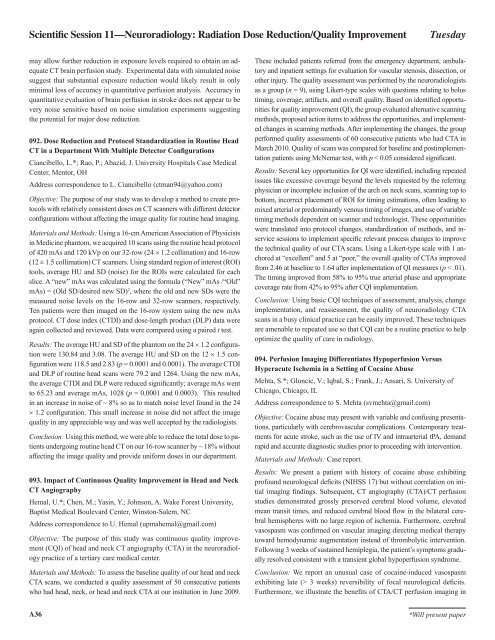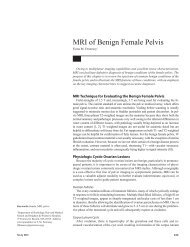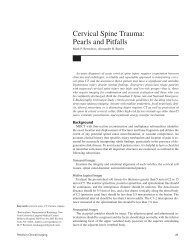Scientific Session 1 â Breast Imaging: Mammography
Scientific Session 1 â Breast Imaging: Mammography
Scientific Session 1 â Breast Imaging: Mammography
Create successful ePaper yourself
Turn your PDF publications into a flip-book with our unique Google optimized e-Paper software.
<strong>Scientific</strong> <strong>Session</strong> 11—Neuroradiology: Radiation Dose Reduction/Quality ImprovementTuesdaymay allow further reduction in exposure levels required to obtain an adequateCT brain perfusion study. Experimental data with simulated noisesuggest that substantial exposure reduction would likely result in onlyminimal loss of accuracy in quantitative perfusion analysis. Accuracy inquantitative evaluation of brain perfusion in stroke does not appear to bevery noise sensitive based on noise simulation experiments suggestingthe potential for major dose reduction.092. Dose Reduction and Protocol Standardization in Routine HeadCT in a Department With Multiple Detector ConfigurationsCiancibello, L.*; Rao, P.; Abazid, J. University Hospitals Case MedicalCenter, Mentor, OHAddress correspondence to L. Ciancibello (ctman94@yahoo.com)Objective: The purpose of our study was to develop a method to create protocolswith relatively consistent doses on CT scanners with different detectorconfigurations without affecting the image quality for routine head imaging.Materials and Methods: Using a 16-cm American Association of Physicistsin Medicine phantom, we acquired 10 scans using the routine head protocolof 420 mAs and 120 kVp on our 32-row (24 × 1.2 collimation) and 16-row(12 ± 1.5 collimation) CT scanners. Using standard region of interest (ROI)tools, average HU and SD (noise) for the ROIs were calculated for eachslice. A “new” mAs was calculated using the formula (“New” mAs /“Old”mAs) = (Old SD/desired new SD) 2 , where the old and new SDs were themeasured noise levels on the 16-row and 32-row scanners, respectively.Ten patients were then imaged on the 16-row system using the new mAsprotocol. CT dose index (CTDI) and dose-length product (DLP) data wereagain collected and reviewed. Data were compared using a paired t test.Results: The average HU and SD of the phantom on the 24 × 1.2 configurationwere 130.84 and 3.08. The average HU and SD on the 12 × 1.5 configurationwere 118.5 and 2.83 (p = 0.0001 and 0.0001). The average CTDIand DLP of routine head scans were 79.2 and 1264. Using the new mAs,the average CTDI and DLP were reduced significantly; average mAs wentto 65.23 and average mAs, 1028 (p = 0.0001 and 0.0003). This resultedin an increase in noise of ~ 8% so as to match noise level found in the 24× 1.2 configuration. This small increase in noise did not affect the imagequality in any appreciable way and was well accepted by the radiologists.Conclusion: Using this method, we were able to reduce the total dose to patientsundergoing routine head CT on our 16-row scanner by ~ 18% withoutaffecting the image quality and provide uniform doses in our department.093. Impact of Continuous Quality Improvement in Head and NeckCT AngiographyHemal, U.*; Chen, M.; Yasin, Y.; Johnson, A. Wake Forest University,Baptist Medical Boulevard Center, Winston-Salem, NCAddress correspondence to U. Hemal (upmahemal@gmail.com)Objective: The purpose of this study was continuous quality improvement(CQI) of head and neck CT angiography (CTA) in the neuroradiologypractice of a tertiary care medical center.Materials and Methods: To assess the baseline quality of our head and neckCTA scans, we conducted a quality assessment of 50 consecutive patientswho had head, neck, or head and neck CTA at our institution in June 2009.These included patients referred from the emergency department, ambulatoryand inpatient settings for evaluation for vascular stenosis, dissection, orother injury. The quality assessment was performed by the neuroradiologistsas a group (n = 9), using Likert-type scales with questions relating to bolustiming, coverage, artifacts, and overall quality. Based on identified opportunitiesfor quality improvement (QI), the group evaluated alternative scanningmethods, proposed action items to address the opportunities, and implementedchanges in scanning methods. After implementing the changes, the groupperformed quality assessments of 60 consecutive patients who had CTA inMarch 2010. Quality of scans was compared for baseline and postimplementationpatients using McNemar test, with p < 0.05 considered significant.Results: Several key opportunities for QI were identified, including repeatedissues like excessive coverage beyond the levels requested by the referringphysician or incomplete inclusion of the arch on neck scans, scanning top tobottom, incorrect placement of ROI for timing estimations, often leading tomixed arterial or predominantly venous timing of images, and use of variabletiming methods dependent on scanner and technologist. These opportunitieswere translated into protocol changes, standardization of methods, and inservicesessions to implement specific relevant process changes to improvethe technical quality of our CTA scans. Using a Likert-type scale with 1 anchoredat “excellent” and 5 at “poor,” the overall quality of CTAs improvedfrom 2.46 at baseline to 1.64 after implementation of QI measures (p < .01).The timing improved from 58% to 95% true arterial phase and appropriatecoverage rate from 42% to 95% after CQI implementation.Conclusion: Using basic CQI techniques of assessment, analysis, changeimplementation, and reassessment, the quality of neuroradiology CTAscans in a busy clinical practice can be easily improved. These techniquesare amenable to repeated use so that CQI can be a routine practice to helpoptimize the quality of care in radiology.094. Perfusion <strong>Imaging</strong> Differentiates Hypoperfusion VersusHyperacute Ischemia in a Setting of Cocaine AbuseMehta, S.*; Gluncic, V.; Iqbal, S.; Frank, J.; Ansari, S. University ofChicago, Chicago, ILAddress correspondence to S. Mehta (svmehta@gmail.com)Objective: Cocaine abuse may present with variable and confusing presentations,particularly with cerebrovascular complications. Contemporary treatmentsfor acute stroke, such as the use of IV and intraarterial tPA, demandrapid and accurate diagnostic studies prior to proceeding with intervention.Materials and Methods: Case report.Results: We present a patient with history of cocaine abuse exhibitingprofound neurological deficits (NIHSS 17) but without correlation on initialimaging findings. Subsequent, CT angiography (CTA)/CT perfusionstudies demonstrated grossly preserved cerebral blood volume, elevatedmean transit times, and reduced cerebral blood flow in the bilateral cerebralhemispheres with no large region of ischemia. Furthermore, cerebralvasospasm was confirmed on vascular imaging directing medical therapytoward hemodynamic augmentation instead of thrombolytic intervention.Following 3 weeks of sustained hemiplegia, the patient’s symptoms graduallyresolved consistent with a transient global hypoperfusion syndrome.Conclusion: We report an unusual case of cocaine-induced vasospasmexhibiting late (> 3 weeks) reversibility of focal neurological deficits.Furthermore, we illustrate the benefits of CTA/CT perfusion imaging inA36*Will present paper
















